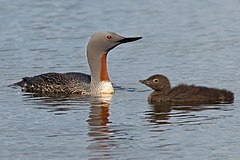Red-throated loon
| Red-throated diver | |
|---|---|
 |
|
| Adult in breeding plumage and recently hatched young | |
| Scientific classification | |
| Kingdom: | Animalia |
| Phylum: | Chordata |
| Class: | Aves |
| Order: | Gaviiformes |
| Family: | Gaviidae |
| Genus: | Gavia |
| Species: | G. stellata |
| Binomial name | |
|
Gavia stellata (Pontoppidan, 1763) |
|
 |
|
|
Breeding summer visitor
Winters at sea or great lakes
|
|
| Synonyms | |
|
Colymbus stellatus Pontoppidan, 1763 |
|
Colymbus stellatus Pontoppidan, 1763
Colymbus lumme Brünnich, 1764
Colymbus septentrionalis Linnaeus, 1766
Gavia lumme Forster, 1788
Colymbus mulleri Brehm, 1826
Urinator lumme Stejneger, 1882
The red-throated loon (North America) or red-throated diver (Britain and Ireland) (Gavia stellata) is a migratory aquatic bird found in the northern hemisphere. The most widely distributed member of the loon or diver family, it breeds primarily in Arctic regions, and winters in northern coastal waters. Ranging from 55 to 67 centimetres (22 to 26 in) in length, the red-throated loon is the smallest and lightest of the world's loons. In winter, it is a nondescript bird, greyish above fading to white below. During the breeding season, it acquires the distinctive reddish throat patch which is the basis for its common name. Fish form the bulk of its diet, though amphibians, invertebrates, and plant material are sometimes eaten as well. A monogamous species, the red-throated loon forms long-term pair bonds. Both members of the pair help to build the nest, incubate the eggs (generally two per clutch), and feed the hatched young.
The red-throated loon has a large global population and a significant global range, though some populations are declining. Oil spills, habitat degradation, pollution, and fishing nets are among the major threats this species faces. Natural predators—including various gull species, and both red and Arctic foxes, will take eggs and young. The species is protected by international treaties.
First described by Danish naturalist Erik Pontoppidan in 1763, the red-throated loon is a monotypic species, with no distinctive subspecies despite its large Holarctic range. Pontoppidan initially placed the species in the now-defunct genus Colymbus, which contained grebes as well as loons. By 1788, German naturalist Johann Reinhold Forster realized that grebes and loons were different enough to warrant separate genera, and moved the red-throated loon (along with all other loon species) to its present genus. Its relationship to the four other loons is complex; although all belong to the same genus, it differs more than any of the others in terms of morphology, behaviour, ecology and breeding biology, and may be the basal lineage of the genus. It is thought to have evolved in the Palearctic, and then to have expanded into the Nearctic. Analysis of molecular data together with the fossil record suggests the lineage of the red-throated loon diverged from that giving rise to the other loon species around 21.4 million years ago in the Miocene. It is also most closely related to the fossil Pliocene species Gavia howardae.
...
Wikipedia

